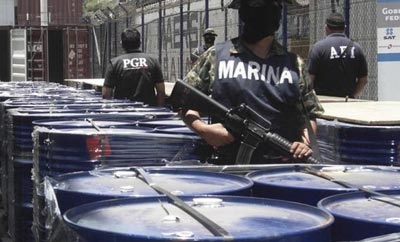The United Nations Office on Drug and Crime (UNODC)’s most recent report on the global narcotics trade has placed a heavy emphasis on the illegal use of precursor chemicals in drug production, reflecting changing tendencies in regional drug production and trafficking and efforts to control the trade.
The 2014 World Drug Report (pdf) highlights the global need to control the diversion of legal chemicals into drug production. According to the report, controlling the overlap between the illicit use of these chemicals and their legal commercialization has been a key aspect in combating the global narcotics trade since the 1990s but the issue has become all the more important with the continued rise in the production and trafficking of synthetic drugs and the migration of cocaine production.
The report’s statistics show a substantial rise in precursor chemicals illegally trafficked in South America. Between 2002 and 2012, the region accounted for 12 percent of the volume seized globally, behind North America with 59 percent. However, when the range is reduced to between 2007 and 2012 the biggest seizures — 60 of the total — were made in South America.
Global seizures of potassium permanganate — the precursor drug used to make cocaine hydrochloride (HCL) — were largely concentrated in Colombia between 2007 and 2012 (80 percent of the total volume). However, compared to the period 2002-2006 average annual seizures in Colombia dropped by half, while Peru and Bolivia saw seizures increase three-fold and 27-fold respectively.
At the same time, Mexico and Central America saw high seizures of the main precursor chemicals used to produce methamphetamine and other amphetamine-type stimulants (ATS) — ephedrine and pseudoephedrine. Central America registered 14 percent of all seizures made globally between 2007 and 2012, and was described as an emerging transit region, while Mexico alone accounted for 11 percent of seizures. In 2012, the number of methamphetamine laboratories dismantled in Mexico rose from 159 to 259, and it remains the country with the highest seizure rate of the drug in the world, followed by the United States — the main market for Mexican meth.
Although interdiction efforts have seen some success in reducing illegal trafficking of chemicals, the annual report highlights the use of sophisticated tactics by criminal groups, such as setting up front companies, in avoiding security controls.
InSight Crime Analysis
Although the UNODC report admits that statistics on precursor chemical trafficking are not easy to translate into hard conclusions regarding their prevalence or use, the information gathered on worldwide seizure trends does provide some insight into the changing reality of the global drug trade.
The falling levels of potassium permanganate seizures in Colombia compared to Peru and Bolivia come at time of a decrease in cocaine production in Colombia, while Peru has taken over as the world’s leading cocaine producer. However, the change also likely reflects changing production techniques as Colombian criminals adapt to controls on chemicals by seeking out uncontrolled substitutes and illegally producing rather than importing substances from the legal market.
Placing controls on chemicals can also lead to a migration of trafficking and production. The development of Central America as a chemical transit region is likely a result of controls on precursors imposed in Mexico in 2008. Since then, not only have chemicals poured into Mexico through Central America, but meth production operations run by Mexican groups, especially the Sinaloa Cartel, have also migrated to Guatemala and Honduras.

